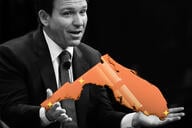You have /5 articles left.
Sign up for a free account or log in.
With scientific expertise sweeping the globe, the next generation of American scientists and engineers are going to face unprecedented competition, and college is too late to begin preparing them for it, according to the National Science Board.
The board released its "Science and Engineering Indicators, 2006" report Thursday. The report, which focused on elementary and secondary education, cast a foreboding tone. According to the report, while the scores of American students on national math assessments have risen slightly in recent years, the same cannot be said for science. According to the 2003 Trends in International Mathematics Science Study , fourth and eighth graders in the United States performed better in math and science than the international average of industrial nations, but improvement since 1995 was modest for eighth graders, and fourth graders took a slight step backward.
Even a fourth grade student who is getting his or her first exposure to science might already be left in the starting blocks, according to Jo Ann Vasquez, a National Science Board member and the lead author of the report. “[Kids] have to get science by third grade,” she said, “or that wonderment disappears.”
What the report means for higher ed, Vasquez added, is that colleges and universities need to portray teaching as a satisfying career possibility for science students, and reach out to teachers in K-12 rather than looking down their noses at them.
Vasquez acknowledged that, for many recent Ph.D. recipients, time spent doing anything but research is seen as time wasted. She said she hopes the culture of the academy can change enough so that teaching for a few years won’t be something fit only for the bottom of the résumé. “If we don’t [change], we’re cutting off our nose to spite our face,” Vasquez said. She urged science departments and education departments to step outside their silos to design programs that focus on prepping teachers, both to be knowledgeable and engaging, for kids as young as kindergarten.
According to the report, as of 2002, nearly one-fourth of science teachers and one-fifth of math teachers did not have certification in the field they were teaching. Vasquez said she’d like to see people with science and math graduate degrees, rather than rushing to academe, “teach for 5 to 10 years,” she said, while doing some research in the summer.
As has been the theme of recommendations to improve science education of late, Vasquez said that industry needs to get involved. She said that companies could benefit from summer researchers with graduate degrees, and that the researcher/teachers could stay abreast of current methods.
Michael Prudich, chair of the chemical engineering department at Ohio University, said that he could envision such an arrangement for a year or so for doctoral candidates who need extra financial support -- if a stipend is arranged. “But 5 to 10 years is a long time,” he added. “If you’re going to be out for 5 or 10 years, you’ll be somewhat out of date in terms of getting back in the academic research market.” As any good math student would quickly realize, 5-10 years of teaching before entering the academy could easily put scholars in their their 40s before they even get evaluated for tenure. Prudich said students with bachelor’s degrees in the sciences would be more likely candidates for long-term teaching. “People who’ve gotten a Ph.D. have made a strong decision about their career,” Prudich added.
Shirley M. Malcom, head of education and human resources for the American Association for the Advancement of Science, said that professors who mentor graduate students should simply let them know it's ok if they don't want to walk in their advisers' footsteps.
According to data from the report, certificate programs might be a good place to recruit science teachers. In 1983, 2,657 computer science certificates were awarded. That number grew to 17,138 in 2002.
Vasquez added that encouraging more women to get science degrees will help. A teaching career, she said, “is attractive to young women. They can take time to have a family,” which can be difficult on the tenure track. In the past two decades, the proportion of science and engineering degrees earned by women has grown prodigiously, reaching 45 percent in 2003, though women earned only 19 percent of engineering degrees in 2003.
Steven C. Beering, president emeritus of Purdue University and a member of the board, said that there’s an opportunity for colleges and universities work with schools and have math and science students and faculty members interact with K-12 teachers to help keep them up to date. “It’s also a wonderful recruiting tool,” Beering said.
“Once you get caught up in the business of teaching,” Beering said. “You get very excited.” Beering said Purdue has a program where faculty members teach prison inmates. At first, Beering said, there was some skepticism about whether faculty members would be interested, but now both some teachers and students are addicted. “We can’t get people out once they get in,” he said. And, surprisingly, the professors aren’t the only ones who want to stay in prison. One student who got a degree from prison, Beering said, “didn’t want to go. He loved his teachers and said he didn’t know anyone on the outside.” If only eighth graders were so well behaved.




